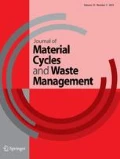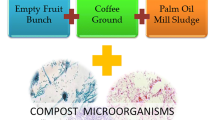Abstract
The magnitude and nature of the waste generated across different borders have prompted the need for an appraisal of the conventional method of waste collection and the landfill or incineration that are unsustainable due to their high cost and impact on the environment and public health. This study focuses on the recycling of organic wastes (food waste and yard trimmings) using four isolated fungal strains in an experimental setup that simulates sustainable low-technology treatment for the production compost. Separated food and yard trimmings were composted using Phanerochaete chrysosporium, Lentinus tigrinus, Aspergillus niger and Penicillium sp. in two adopted systems (open and closed) based on a solid-state bioconversion process. The results were obtained at p ≤ 0.05 after ten harvests indicating a pH range of 5.68–8.82, an organic weight loss of 11.92 % and a carbon-to-nitrogen (C/N) ratio range of 16.99–18.20 for the open system of the compost. The closed system indicated a relatively lower value of C/N ratio, which is 8.60–13.38 and an organic weight loss of 8.92 % at a pH range of 5.68–7.30. The germination index, ranging between 53–105 and 49–122 %, and the electrical conductivity ranging between 2.57–3.17 and 2.72–2.95 mS/dm for the open and closed systems, respectively, were used to evaluate the toxicity and stability of the compost produced. The technology adopted in this study indicates the viability of the process of the large-scale production of biofertilizer with the C/N ratio of <25 and the significance of the germination index values of >100 % at harvest.







Similar content being viewed by others
References
Idris A, Inanc B, Hassan MN (2004) Overview of waste disposal and landfills/dumps in Asian countries. J Mater Cycles Waste Manag 6(2):104–110
Adhikari B, Barrington S, Martinez J (2009) Urban food waste generation: challenges and opportunities. Int J Environ Waste Manag 3(1):4–21
EPA (2006) Composting: publications, fact and figures. Environmental Protection Agency. http://www.epa.gov/epaoswer/non-hw/compost/cytmsw.pdf, http://www.epa.gov/epawaste/conserve/rrr/composting/pubs/index.htm
Goldstein N (2005) Source separated MSW composting in the U.S. BioCycle 46(12):20–26
Saeed M, Hassan M, Mujeebu M (2009) Assessment of municipal solid waste generation and recyclable materials potential in Kuala Lumpur, Malaysia. Waste Manag 29(7):2209–2213
Periathamby A, Hamid F, Khidzir K (2009) Evolution of solid waste management in Malaysia: impacts and implications of the solid waste bill. J Mater Cycles Waste Manag 11(2):96–103
World Bank (2008) Report on municipal solid waste treatment technologies and carbon finance in East Asia. http://www.worldbank.org/solidwaste
Opatokun SA, Kabbashi NA, Alam MZ (2010) Evaluation of physicochemical parameters of leachates from municipal solid waste compactors. Paper presented at the second international conference on environmental research and technology (ICERT 2010), Penang, pp 602–605
Renou S, Givaudan JG, Poulain S, Dirassouyan F, Moulin P (2008) Landfill leachate treatment: review and opportunity. J Hazard Mater 150(3):468–493. doi:10.1016/j.jhazmat.2007.09.077
Alam MZ (2009) Solid state bioconversion of oil palm empty fruit bunches for cellulase enzyme production using a rotary drum bioreactor. Biochem Eng J 46(1):61–64
Molla A, Fakhru’l-Razi A, Hanafi M, Alam MZ (2004) Optimization of process factors for solid-state bioconversion of domestic wastewater sludge. Int Biodeterior Biodegrad 53(1):49–55
Adhikari B, Barrington S, Martinez J, King S (2008) Characterization of food waste and bulking agents for composting. Waste Manag 28(5):795–804
Rashid S, Alam M, Karim M, Salleh M (2009) Management of palm oil mill effluent through production of cellulases by filamentous fungi. World J Microbiol Biotechnol 25(12):2219–2226
Gaind S, Pandey AK, Lata N (2005) Biodegradation study of crop residues as affected by exogenous inorganic nitrogen and fungal inoculants. J Basic Microbiol 4:301–311
Tuomela M, Vikman M, Hatakka A, Itävaara M (2000) Biodegradation of lignin in a compost environment: a review. Bioresour Technol 72(2):169–183
Haug RT (1993) The practical handbook of compost engineering. CRC Publishers Ltd., Boca Raton
Sherman R (2005) Large-scale organic materials composting. North Carolina Cooperative Extension Service. http://www.bae.ncsu.edu/bae/programs/extension/publicat/vermcompost/ag593.pdf. Accessed 23 Oct 2010
Wong JWC, Mak KF, Chan NW, Lam A, Fang M, Zhou LX (2001) Co-composting of soybean residues and leaves in Hong Kong. Bioresour Technol 76(2):99–106. doi:10.1016/S0960-8524(00)00103-6
Butler T, Sikora L, Steinhilber P, Douglass L (2001) Compost age and sample storage effects on maturity indicators of biosolids compost
Barrington S, Choinière D, Trigui M, Knight W (2002) Effect of carbon source on compost nitrogen and carbon losses. Bioresour Technol 83(3):189–194. doi:10.1016/S0960-8524(01)00229-2
Tiquia S (2003) Evaluation of organic matter and nutrient composition of partially decomposed and composted spent pig litter. Environ Technol 24(1):97–107
Liang C, Das K, McClendon R (2003) The influence of temperature and moisture contents regimes on the aerobic microbial activity of a biosolids composting blend. Bioresour Technol 86(2):131–137
Betton CI (1992) Lubricants and their environmental impact. In: Mortier RM, Orszulik ST (eds) Chemistry and technology of lubricants. Blackies Academic and Professional Press, London, pp 282–298
Haddadin M, Haddadin J, Arabiyat O, Hattar B (2009) Biological conversion of olive pomace into compost by using Trichoderma harzianum and Phanerochaete chrysosporium. Bioresour Technol 100(20):4773–4782
Hsu Jenn-Hung, Lo Shang-Lien (1999) Chemical and spectroscopic analysis of organic matter transformations during composting of pig manure. Environ Pollut 104(2):189–196
Ashraf R, Shahid F, Ali TA (2007) Association of fungi, bacteria and actinomycetes with different composts. Pak J Bot 39:2141–2151
Sánchez-Monedero MA, Roig A, Paredes C, Bernal MP (2001) Nitrogen transformation during organic waste composting by the Rutgers system and its effects on pH, EC and maturity of the composting mixtures. Bioresour Technol 78(3):301–308. doi:10.1016/S0960-8524(01)00031-1
Wu L, Ma L (2001) Effects of sample storage on biosolids compost stability and maturity evaluation. J Environ Qual 30(1):222–228
Locci E, Laconi S, Pompei R, Scano P, Lai A, Marincola F (2008) Wheat bran biodegradation by Pleurotus ostreatus: a solid-state Carbon-13 NMR study. Bioresour Technol 99(10):4279–4284
Campbell AG, Engebretson RR, Tripepi RR (1991) Composting a combined RMP/CMP pulp and paper sludge. Tech Assoc Pulp Paper Ind 74(9):183–191
Tiquia S, Tam N (2000) Fate of nitrogen during composting of chicken litter. Environ Pollut 110(3):535–541
Lee J, Gwak K, Park J, Park M, Choi D, Kwon M (2007) Biological pretreatment of softwood Pinus densiflora by three white rot fungi. J Microbiol 45(6):485–491
Beck-Friis B, Pell M, Sonesson U, Jonsson H, Kirchmann H (2000) Formation and emission of N2O and CH4, from compost heaps of organic household waste. Environ Monit Assess 62:317–325
Ogunwande G, Osunade J, Adekalu K, Ogunjimi L (2008) Nitrogen loss in chicken litter compost as affected by carbon to nitrogen ratio and turning frequency. Bioresour Technol 99(16):7495–7503
Sundberg C, Smårs S, Jönsson H (2004) Low pH as an inhibiting factor in the transition from mesophilic to thermophilic phase in composting. Bioresour Technol 95(2):145–150. doi:10.1016/j.biotech.2004.01.016
Lei F, VanderGheynst JS (2000) The effect of microbial inoculation and pH on microbial community structure changes during composting. Process Biochem 35(9):923–929. doi:10.1016/S0032-9592(99)00155-7
Fang M, Wong JWC, Ma KK, Wong MH (1999) Co-composting of sewage sludge and coal fly ash: nutrient transformations. Bioresour Technol 67(1):19–24. doi:10.1016/S0960-8524(99)00095-4
Ho G, Qiao L (1998) Chromium speciation in municipal solid waste: effects of clay amendment and composting. Water Sci Technol 38(2):17–23
Wong JWC, Li SWY, Wong MH (1995) Coal fly ash as a composting material for sewage sludge: effects on microbial activities. Environ Technol 16:527–537
Mato S, Otero D, Garcia M (1994) Composting of <100 mm fraction of municipal solid waste. Waste Manag Res 12(4):315–322
Gaind S, Nain L, Patel V (2009) Quality evaluation of co-composted wheat straw, poultry droppings and oil seed cakes. Biodegradation 20(3):307–317
Batista L, Chalfoun S, Prado G, Schwan R, Wheals A (2003) Toxigenic fungi associated with processed (green) coffee beans (Coffea arabica L.). Int J Food Microbiol 85(3):293–300
Sommer S (2001) Effect of composting on nutrient loss and nitrogen availability of cattle deep litter. Eur J Agron 14(2):123–133
Tai HS, He WH (2007) A novel composting process for plant wastes in Taiwan military barracks. Resour Conserv Recycl 51:408–417
Tiquia SM, Richard TL, Honeyman MS (2002) Carbon nutrient and mass loss during composting. Nutr Cycl Agroecosyst 62:15–24
Iyengar SR, Bhave PP (2006) In-vessel composting of household wastes. Waste Manag 26(10):1070–1080. doi:10.1016/j.wasman.2005.06.011
Singh A, Sharma S (2002) Composting of a crop residue through treatment with microorganisms and subsequent vermicomposting. Bioresour Technol 85(2):107–111. doi:10.1016/S0960-8524(02)00095-0
Vourinen AH, Saharinen MH (1997) Evolution of microbiological and chemical parameters during manure and straw co-composting in a drum composting system. Agric Ecosyst Environ 66:19–29
Perkinson R, Gibbs P, Burchett S, Misselbrook T (2004) Effect of turning regime and seasonal weather conditions on nitrogen and phosphorus losses during aerobic composting of cattle manure. Bioresour Technol 91:171–178
Nies DH (1999) Microbial heavy-metal resistance. Appl Microbiol Biotechnol 51(6):730–750
Brinton WF (2001) An international look at compost standards. Biocycle 42(4):74–76
Acknowledgments
The work was financially supported by Research Endowment B (EDW/B/0905-299) under Research Management Centre of International Islamic University, Malaysia. Furthermore, the contributions and support of the Daya Basil Sdn. Bhd. staffs especially Siti Nor Ainie Ishak were also appreciated.
Author information
Authors and Affiliations
Corresponding author
Rights and permissions
About this article
Cite this article
Adebayo, O.S., Kabbashi, N.A., Alam, M.Z. et al. Recycling of organic wastes using locally isolated lignocellulolytic strains and sustainable technology. J Mater Cycles Waste Manag 17, 769–780 (2015). https://doi.org/10.1007/s10163-014-0309-z
Received:
Accepted:
Published:
Issue Date:
DOI: https://doi.org/10.1007/s10163-014-0309-z




